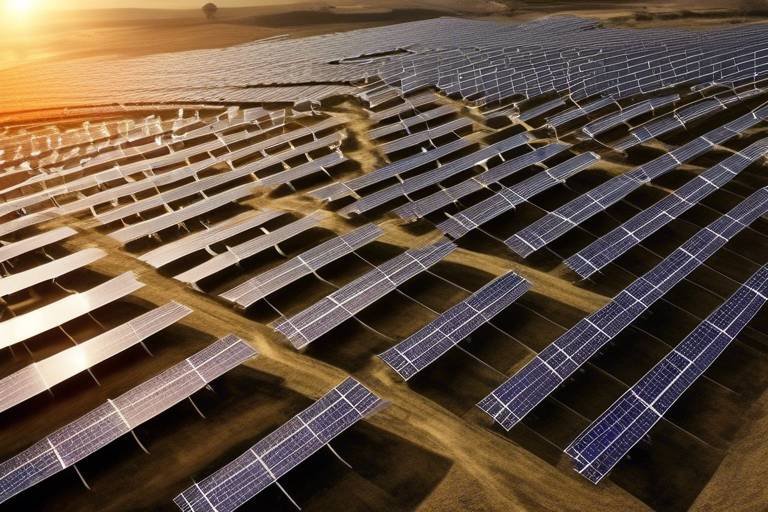The Story of Green Energy in Industrial Revolution 4.0
The fourth industrial revolution, often referred to as Industry 4.0, is not just about technological advancements; it’s a profound shift towards sustainability and green energy. In this era, we’re witnessing a remarkable transformation that intertwines cutting-edge technology with a commitment to the environment. Imagine a world where factories are not just hubs of production but also champions of sustainability, utilizing renewable resources to power their operations. This is the essence of the green energy movement that is reshaping industries globally.
As we delve deeper into this narrative, we can see that the integration of renewable energy technologies—like solar, wind, and hydroelectric power—has become pivotal. These technologies are no longer just experimental; they are being woven into the fabric of industrial processes. Picture a manufacturing plant where the sun’s rays are harnessed to generate electricity, or where wind turbines provide the necessary power to operate heavy machinery. This shift is not just beneficial for the planet; it’s also economically advantageous, providing industries with a reliable and often cheaper source of energy.
But why is this shift happening now? The answer lies in the growing awareness of environmental issues and the urgent need to address climate change. Industries are recognizing that their operations have a significant impact on the environment, and there is a collective push towards reducing carbon footprints. The transition to green energy is not merely a trend; it’s a necessity that aligns with global environmental goals. Companies that embrace this change are not just improving their sustainability practices; they are also enhancing their brand image and gaining competitive advantages in a market that increasingly values eco-friendliness.
Moreover, the implementation of energy-efficient practices in manufacturing is becoming a cornerstone of this revolution. Industries are optimizing energy use through innovative technologies and processes, leading to significant reductions in waste and energy consumption. Think of it as a well-oiled machine where every part works harmoniously to minimize energy loss. The benefits are twofold: reduced operational costs and a smaller environmental impact.
In addition to these practices, smart grids are playing a crucial role in enhancing energy management. These advanced systems allow industries to monitor and control their energy consumption effectively, integrating renewable sources seamlessly. Imagine being able to adjust your energy usage in real-time based on availability and demand, ensuring that your operations are both efficient and sustainable. This level of control is not just a dream; it’s becoming a reality thanks to technological advancements.
However, the journey towards green energy is not without its challenges. Industries face various obstacles, from financial constraints to technological barriers. Transitioning to renewable energy solutions often requires a substantial upfront investment, which can deter many companies. But it's essential to recognize that the long-term economic benefits can far outweigh these initial costs. With the right government policies and incentives, such as subsidies and tax credits, the path to sustainability can become more accessible.
As we navigate through this exciting yet complex landscape, it’s crucial to acknowledge both the successes and the challenges faced by industries. Case studies of successful implementations of green energy solutions illustrate the tangible benefits and hurdles encountered along the way. These real-world examples serve as a beacon of hope and a roadmap for others looking to embark on a similar journey.
In conclusion, the story of green energy in the fourth industrial revolution is one of innovation, resilience, and hope. It’s a narrative that showcases how industries can evolve to meet the demands of a changing world while contributing positively to the environment. As we continue to explore this topic, let’s keep the conversation going about how we can further embrace sustainability in our industrial practices.
- What is green energy? Green energy refers to energy derived from renewable, natural sources that have a minimal impact on the environment, such as solar, wind, and hydroelectric power.
- How does green energy contribute to industrial sustainability? Green energy reduces carbon emissions and reliance on fossil fuels, promoting eco-friendly practices and aligning with global sustainability goals.
- What are smart grids? Smart grids are advanced electrical grids that use technology to monitor and manage energy flow, allowing for better integration of renewable energy sources.
- What challenges do industries face in transitioning to green energy? Common challenges include financial constraints, technological barriers, and resistance to change within organizations.

The Rise of Renewable Energy Technologies
The fourth industrial revolution has been nothing short of a game-changer for renewable energy technologies. As we stand on the brink of a new era, the integration of solar, wind, and hydroelectric power into industrial processes is reshaping how industries operate. Imagine a world where factories run on clean energy, significantly reducing their carbon footprints while boosting productivity. This shift is not just a dream; it's becoming a reality!
Solar energy, for instance, has evolved from being a niche market to a mainstream power source. The advancements in photovoltaic technology have made solar panels more efficient and affordable than ever. Today, large-scale solar farms are popping up across the globe, harnessing the sun's energy to power entire cities. In fact, according to recent research, the cost of solar energy has dropped by over 80% in the past decade, making it a viable option for industries looking to reduce operational costs.
Wind energy is another powerhouse in the renewable sector. With towering wind turbines spinning gracefully on land and offshore, this technology has seen remarkable advancements. Modern wind turbines are not only taller and more efficient but also equipped with smart technology that optimizes their performance. The International Energy Agency (IEA) reports that wind energy could provide up to 18% of the world's electricity by 2030, a testament to its growing significance in the energy landscape.
Hydroelectric power, often considered the grandfather of renewable energy, continues to play a crucial role in this revolution. With advancements in turbine technology and the development of small-scale hydro systems, industries can now tap into this abundant resource without the environmental drawbacks associated with large dams. In fact, many companies are now investing in run-of-the-river hydroelectric systems, which generate power with minimal impact on local ecosystems.
As these renewable technologies rise, they are not just standalone solutions; they are increasingly being integrated into a broader industrial framework. The concept of a circular economy is gaining traction, where waste from one process becomes the input for another. This synergy between renewable energy and industrial processes is fostering a sustainable future, where energy efficiency and environmental responsibility go hand in hand.
However, the journey towards widespread adoption of these technologies is not without its challenges. Industries must navigate the complexities of transitioning from traditional energy sources to renewables. This includes understanding the technological requirements, investing in new infrastructure, and often, overcoming cultural resistance. Yet, the rewards are significant. Companies that embrace renewable energy not only contribute to a healthier planet but also position themselves competitively in a market that increasingly values sustainability.
In conclusion, the rise of renewable energy technologies during the fourth industrial revolution is a testament to human innovation and resilience. As we continue to develop and integrate these solutions into our industrial practices, we are paving the way for a sustainable future—a future where energy is clean, abundant, and accessible to all.

Impact on Industrial Sustainability
As we delve into the impact of green energy on industrial sustainability, it's crucial to recognize how these initiatives are reshaping the landscape of manufacturing and production. The shift towards renewable energy sources is not just a trend; it's a fundamental change that is helping industries reduce their carbon footprints while promoting eco-friendly practices. This transition is akin to a breath of fresh air for the industrial sector, which has historically been associated with heavy pollution and resource depletion.
One of the most significant advantages of adopting green energy is the substantial reduction in greenhouse gas emissions. Industries that switch to renewable energy sources like solar, wind, and hydroelectric power can dramatically cut down on their reliance on fossil fuels. This shift is not merely about compliance with regulations; it's about creating a sustainable future that aligns with global environmental goals. According to recent studies, companies that embrace green energy not only help the planet but also enhance their brand image, attracting environmentally-conscious consumers.
Moreover, integrating renewable energy into industrial processes fosters a culture of sustainability. When companies invest in green technologies, they often implement energy-efficient practices that lead to significant cost savings. For instance, energy-efficient machinery and optimized production processes can reduce energy consumption by up to 30%. This not only lowers operational costs but also improves profitability in the long run.
To illustrate the impact of green energy on sustainability, consider the following table that summarizes the benefits:
| Benefit | Description |
|---|---|
| Reduced Emissions | Lower greenhouse gas emissions through renewable energy use. |
| Cost Savings | Significant reductions in energy costs due to efficiency. |
| Brand Enhancement | Improved public perception and customer loyalty. |
| Regulatory Compliance | Easier adherence to environmental regulations. |
In addition to these benefits, green energy initiatives also promote innovation within industries. Companies are increasingly exploring new technologies and processes that not only enhance productivity but also minimize environmental impact. This drive for innovation is like planting seeds for a greener tomorrow, where industries can thrive while preserving the planet.
Furthermore, the collective impact of industries adopting green energy is profound. When multiple sectors embrace sustainability, the ripple effect can lead to a significant reduction in national and global carbon emissions. This collaborative effort is essential as we face the pressing challenge of climate change. By working together, industries can create a robust ecosystem that supports sustainable practices and encourages the use of renewable resources.
In conclusion, the impact of green energy on industrial sustainability is both transformative and essential. As industries continue to evolve in the era of the fourth industrial revolution, the integration of renewable energy will play a pivotal role in shaping a sustainable future. The question is not whether industries should adopt green energy, but rather how quickly can they do so to reap the benefits for both their operations and the environment.

Energy Efficiency in Manufacturing
In the fast-paced world of manufacturing, energy efficiency has emerged as a critical component of operational success. As industries strive to reduce costs and environmental impact, the focus on optimizing energy use has never been more pivotal. Imagine a factory that runs like a well-oiled machine, where every kilowatt is utilized to its fullest potential—this is the vision that many manufacturers are now striving to achieve. By embracing innovative technologies and practices, companies can not only enhance their productivity but also contribute to a more sustainable future.
One of the most effective ways to improve energy efficiency in manufacturing is through the adoption of smart technologies. These technologies include advanced sensors, automation systems, and data analytics, which allow manufacturers to monitor energy consumption in real-time. For instance, factories can now utilize Internet of Things (IoT) devices to track energy usage across various machines and processes. This data-driven approach enables businesses to identify inefficiencies and make informed decisions that lead to significant energy savings.
Moreover, energy-efficient manufacturing practices are not just about cutting down on energy usage; they also involve process optimization. By re-evaluating production workflows, manufacturers can streamline operations to minimize waste and energy consumption. For example, implementing lean manufacturing principles can help eliminate unnecessary steps in the production process, ultimately leading to a reduction in energy use. This approach not only enhances productivity but also aligns with the broader goals of sustainability and environmental stewardship.
To further illustrate the impact of energy efficiency in manufacturing, consider the following table that outlines the potential energy savings from various efficiency initiatives:
| Initiative | Potential Energy Savings (%) | Impact on Costs |
|---|---|---|
| Upgrading to LED Lighting | 30-50% | Lower electricity bills |
| Implementing Variable Frequency Drives (VFDs) | 20-40% | Reduced operational costs |
| Optimizing HVAC Systems | 10-30% | Improved comfort and productivity |
| Utilizing Energy Management Systems (EMS) | 15-25% | Enhanced decision-making |
As the table highlights, various initiatives can lead to substantial energy savings, translating into lower operational costs and a more sustainable manufacturing process. However, it's essential to recognize that implementing these changes requires an initial investment, which can be a barrier for some companies. Nevertheless, the long-term benefits often outweigh the upfront costs, making a compelling case for the transition to energy-efficient practices.
Furthermore, training and engaging employees in energy efficiency initiatives can significantly enhance their effectiveness. When workers understand the importance of energy conservation and are equipped with the knowledge to implement energy-saving practices, they become valuable allies in the quest for efficiency. This cultural shift towards sustainability can lead to innovative ideas and solutions that further enhance a company's energy performance.
In conclusion, energy efficiency in manufacturing is not just a trend; it is a necessity for businesses aiming to thrive in the era of Industrial Revolution 4.0. By leveraging technology, optimizing processes, and fostering a culture of sustainability, manufacturers can achieve remarkable improvements in their energy consumption. As we move forward, the commitment to energy efficiency will undoubtedly play a crucial role in shaping a more sustainable and economically viable manufacturing landscape.
- What is energy efficiency in manufacturing?
Energy efficiency in manufacturing refers to the practice of using less energy to produce the same amount of goods, thereby reducing costs and environmental impact. - How can manufacturers improve energy efficiency?
Manufacturers can improve energy efficiency by adopting smart technologies, optimizing production processes, and engaging employees in energy-saving practices. - What are some examples of energy-efficient technologies?
Examples include LED lighting, variable frequency drives (VFDs), and energy management systems (EMS). - What are the financial benefits of improving energy efficiency?
Improving energy efficiency can lead to lower operational costs, reduced energy bills, and enhanced profitability in the long run.

Smart Grids and Energy Management
In the ever-evolving landscape of the fourth industrial revolution, smart grids have emerged as a cornerstone for effective energy management. Imagine a network that not only distributes electricity but also intelligently communicates with devices, optimizing energy use in real-time. This is the essence of smart grids—integrated systems that leverage advanced technologies to enhance the efficiency and reliability of energy distribution. They serve as the nervous system of modern energy management, connecting various sources of energy, including renewable resources like solar and wind, to consumers and industries alike.
One of the most fascinating aspects of smart grids is their ability to monitor energy consumption in real-time. This capability allows industries to adjust their energy usage based on demand, significantly reducing waste. For instance, during peak hours, a manufacturing plant can temporarily lower its energy consumption by optimizing machinery operations or shifting production schedules. The result? A more balanced load on the grid and substantial cost savings. This kind of dynamic energy management is not just a luxury; it's becoming a necessity as industries strive to meet sustainability goals while maintaining profitability.
Moreover, smart grids facilitate the integration of renewable energy sources into the existing energy infrastructure. Traditionally, the unpredictability of renewable energy generation—like solar panels producing energy only when the sun shines—posed challenges for industries. However, with smart grid technology, energy from these sources can be stored and dispatched as needed, ensuring a steady supply. This flexibility is crucial as industries pivot towards greener practices, allowing them to depend less on fossil fuels and more on sustainable energy solutions.
To illustrate the impact of smart grids on energy management, consider the following table, which outlines key benefits:
| Benefit | Description |
|---|---|
| Real-Time Monitoring | Enables industries to track energy usage and make adjustments instantly. |
| Cost Efficiency | Reduces energy costs by optimizing consumption and minimizing waste. |
| Integration of Renewables | Facilitates the use of solar, wind, and other renewable sources effectively. |
| Enhanced Reliability | Improves the stability of energy supply and reduces outages. |
Furthermore, the implementation of smart grids is not just a technical upgrade; it's a cultural shift within organizations. Industries are increasingly recognizing the importance of data analytics in energy management. By harnessing data collected from smart grids, businesses can gain insights into their energy consumption patterns, identify inefficiencies, and make informed decisions. This data-driven approach empowers industries to not only reduce their carbon footprint but also enhance their overall operational efficiency.
As we look towards the future, the role of smart grids in energy management will only continue to grow. They represent a crucial step towards a more sustainable industrial landscape, where energy is used wisely and efficiently. The transition may not be without its challenges, but the potential benefits—both environmental and economic—are too significant to ignore. In this new era, industries that embrace smart grid technology will not only lead the charge in sustainability but will also set themselves apart in an increasingly competitive market.
- What are smart grids? Smart grids are advanced electrical grids that use digital technology to monitor and manage the transport of electricity from all generation sources to meet the varying electricity demands of end-users.
- How do smart grids benefit industries? They provide real-time monitoring, cost efficiency, and enhanced reliability, while also facilitating the integration of renewable energy sources.
- Can smart grids help reduce carbon footprints? Yes, by optimizing energy consumption and promoting the use of renewable energy, smart grids significantly contribute to lowering carbon emissions.

Case Studies of Successful Implementations
As we delve into the world of green energy, it's essential to highlight some inspiring case studies that showcase how industries have successfully integrated renewable energy solutions into their operations. These examples not only demonstrate the feasibility of such initiatives but also provide valuable insights into the benefits and challenges faced during implementation.
One notable case is that of Siemens Gamesa Renewable Energy, a leader in wind turbine manufacturing. The company has made significant strides in reducing its carbon footprint by utilizing 100% renewable energy in its production facilities. By investing in wind and solar power, Siemens Gamesa has not only decreased its operational costs but has also positioned itself as a pioneer in sustainable manufacturing. Their commitment to green energy has led to a remarkable reduction in greenhouse gas emissions, setting a benchmark for others in the industry.
Another compelling example comes from Unilever, a global consumer goods company that has embraced sustainability as part of its core business strategy. Unilever has implemented a comprehensive plan to power its factories with renewable energy sources, aiming for all its manufacturing sites to achieve this goal by 2030. As of now, over half of Unilever's energy needs are met through renewable sources, significantly lowering its carbon emissions. This shift not only enhances their brand image but also aligns with their commitment to sustainable sourcing and production.
Additionally, the automotive industry has seen significant transformations with companies like Tesla leading the charge. Tesla’s Gigafactory in Nevada is a prime example of integrating renewable energy into large-scale manufacturing. The factory is designed to run on solar energy and aims to produce batteries and electric vehicles at an unprecedented scale while minimizing environmental impact. The implementation of energy-efficient technologies and renewable energy sources has allowed Tesla to reduce costs and improve productivity, setting a new standard for the automotive sector.
To further illustrate these successes, let’s take a look at a table summarizing key aspects of these case studies:
| Company | Industry | Renewable Energy Source | Goals | Achievements |
|---|---|---|---|---|
| Siemens Gamesa | Wind Energy | Wind and Solar | 100% renewable energy in production | Significant reduction in emissions |
| Unilever | Consumer Goods | Various Renewables | All factories powered by renewables by 2030 | Over 50% renewable energy usage |
| Tesla | Automotive | Solar Energy | Maximize renewable energy in Gigafactory | Reduced costs and improved productivity |
These case studies not only highlight the potential of green energy in reshaping industrial practices but also emphasize the importance of commitment from businesses. The journey towards sustainability is not without its challenges, but the successes of Siemens Gamesa, Unilever, and Tesla serve as powerful reminders that a greener future is indeed achievable. By learning from these examples, other industries can pave their own paths towards integrating renewable energy solutions, ultimately contributing to a more sustainable and eco-friendly world.
Q: What are the main benefits of implementing green energy in industries?
A: The primary benefits include reduced carbon emissions, lower operational costs, enhanced brand reputation, and alignment with global sustainability goals.
Q: Are there any financial incentives for industries transitioning to green energy?
A: Yes, many governments offer subsidies, tax credits, and other financial incentives to encourage the adoption of renewable energy solutions.
Q: What challenges do industries face when transitioning to green energy?
A: Common challenges include financial constraints, technological barriers, and resistance to change among stakeholders.

Government Policies and Incentives
When it comes to the adoption of green energy, government policies and incentives play a pivotal role in shaping the landscape. Imagine trying to climb a steep hill without any support; that’s what transitioning to renewable energy can feel like for many industries without the right backing. Governments around the globe have recognized this challenge and are stepping in with a variety of supportive measures designed to ease the transition. These policies not only motivate companies to adopt sustainable practices but also help in creating a more favorable environment for innovation and investment in green technologies.
One of the most common forms of support comes in the shape of subsidies. These financial aids can significantly reduce the initial costs associated with installing renewable energy systems such as solar panels or wind turbines. For example, a manufacturing company considering a solar energy installation might receive a subsidy that covers up to 30% of the total installation cost. This can make the difference between a company going green or sticking with traditional energy sources. In addition to subsidies, governments often provide tax credits that allow businesses to deduct a portion of their investment in renewable energy from their taxable income, further enhancing the financial viability of green projects.
Moreover, regulatory frameworks are crucial in establishing a clear path for industries to follow. These regulations can include renewable portfolio standards (RPS), which require utility companies to obtain a certain percentage of their energy from renewable sources. This not only promotes the use of green energy but also creates a market for renewable technologies, encouraging companies to innovate and invest in cleaner energy solutions. For instance, states like California have set ambitious goals for renewable energy adoption, pushing industries to explore and implement sustainable practices.
| Type of Incentive | Description | Example |
|---|---|---|
| Subsidies | Financial aids that reduce the cost of renewable energy installations. | 30% subsidy on solar panel installation costs. |
| Tax Credits | Deductions that lower taxable income based on renewable energy investments. | Investment tax credit for solar energy systems. |
| Regulatory Frameworks | Rules that mandate energy companies to utilize renewable sources. | Renewable portfolio standards in California. |
Additionally, governments often implement grants and low-interest loans specifically aimed at businesses looking to transition to green energy. These financial tools can help mitigate the burden of upfront costs, making it easier for companies to take the plunge into renewable energy. For example, a small business might qualify for a low-interest loan to install energy-efficient equipment, allowing them to save on energy costs while paying off their investment over time.
However, while these policies are beneficial, they are not without their challenges. The effectiveness of incentives can vary widely from one region to another, and sometimes the application process can be cumbersome and complex, deterring businesses from taking advantage of available programs. Additionally, the political landscape can influence the stability and availability of these incentives, leading to uncertainty for companies planning long-term investments in green technologies.
In conclusion, government policies and incentives are crucial in the transition to green energy for industries. They provide the necessary support and encouragement, helping to level the playing field for businesses looking to adopt sustainable practices. As we continue to navigate the complexities of the fourth industrial revolution, these initiatives will be instrumental in driving the shift towards a more sustainable and environmentally friendly industrial landscape.
- What are the main types of government incentives for green energy? Governments typically offer subsidies, tax credits, grants, and low-interest loans to encourage the adoption of renewable energy.
- How do subsidies impact the cost of renewable energy? Subsidies reduce the upfront costs of renewable energy installations, making them more financially viable for businesses.
- Are there any risks associated with government incentives? Yes, the availability and effectiveness of incentives can vary by region and may change with political shifts, creating uncertainty for businesses.

Challenges in Transitioning to Green Energy
Transitioning to green energy is like climbing a steep mountain; the view from the top is breathtaking, but the journey can be fraught with challenges. Many industries are eager to embrace renewable resources, but the path isn’t always smooth. One of the most significant hurdles is the financial implications. Initial investments in green technologies can be substantial, often requiring companies to allocate a large portion of their budgets. This can be especially daunting for small and medium-sized enterprises (SMEs) that may already be operating on tight margins.
Moreover, the technological barriers can seem insurmountable. Not all industries have the infrastructure in place to support the integration of renewable energy sources. For instance, manufacturing plants may need to upgrade their equipment or invest in new technologies to harness solar or wind energy effectively. These upgrades can involve complex engineering challenges and require specialized knowledge that may not be readily available in-house.
Resistance to change is another significant barrier. Many organizations are set in their ways, using traditional energy sources that have served them well for years. Shifting to green energy often requires a cultural change within the company, which can be met with skepticism. Employees may be hesitant to adopt new practices, fearing that change could disrupt their daily routines or lead to job losses. To combat this, it’s essential for leadership to communicate the long-term benefits of green energy, not just for the environment, but for the company’s bottom line as well.
In addition to these challenges, the regulatory landscape is constantly evolving. Different regions have varying policies regarding renewable energy, and keeping up with these regulations can be a daunting task for companies. Some may find themselves navigating a maze of subsidies, tax credits, and compliance requirements, which can complicate the decision-making process. It’s crucial for industries to stay informed and possibly engage with policy experts to ensure they are capitalizing on available incentives.
Here’s a brief overview of the key challenges faced by industries transitioning to green energy:
- Financial Constraints: High upfront costs and uncertain returns on investment.
- Technological Barriers: Need for new infrastructure and specialized knowledge.
- Resistance to Change: Cultural inertia and fear of disruption among employees.
- Regulatory Challenges: Navigating complex and varying energy policies.
Despite these challenges, the transition to green energy is not only necessary but also feasible. Companies that invest in renewable resources can ultimately reap significant long-term benefits, including reduced energy costs, enhanced brand reputation, and compliance with increasingly stringent environmental regulations. The key is to approach the transition strategically, addressing each challenge head-on with innovative solutions and a commitment to sustainability.
1. What are the main challenges industries face when transitioning to green energy?
Industries often encounter financial constraints, technological barriers, resistance to change, and regulatory challenges.
2. How can companies overcome financial challenges associated with green energy?
Companies can explore grants, subsidies, and tax incentives, as well as consider long-term savings on energy costs to justify the initial investment.
3. What role does employee engagement play in the transition to green energy?
Engaging employees in the process can help alleviate fears and resistance, fostering a culture that embraces sustainability and innovation.
4. Are there specific technologies that can help industries transition to green energy?
Yes, technologies such as solar panels, wind turbines, and energy-efficient machinery can significantly aid in the transition.

Financial Implications for Industries
The transition to green energy brings a whirlwind of financial implications for industries, and understanding these can feel like navigating a maze. On one hand, the upfront costs associated with adopting renewable technologies can seem daunting. Installing solar panels, wind turbines, or advanced energy management systems often requires significant capital investment. However, these costs are just the tip of the iceberg. Companies must also consider ongoing maintenance, training for staff, and potential disruptions during the transition period.
But don’t let those numbers scare you away! The truth is, while the initial investment can be high, the long-term economic benefits are often worth it. Industries that embrace green energy typically experience lower operational costs over time. For instance, once a solar panel system is installed, the cost of generating electricity drops significantly, often leading to savings that can be reinvested into the business. Furthermore, as technology continues to advance, the costs of renewable energy solutions are steadily declining, making them more accessible than ever.
Moreover, there are government incentives that can help mitigate these financial burdens. Many governments offer subsidies, tax credits, and grants aimed at encouraging industries to adopt green practices. These incentives can significantly reduce the financial strain of transitioning to renewable energy sources. For example, a company investing in energy-efficient machinery may qualify for tax breaks that reduce its overall tax liability, making the switch more appealing.
To illustrate the financial implications further, let’s take a look at a hypothetical scenario where a manufacturing company transitions to solar energy:
| Cost Category | Initial Investment | Annual Savings | Payback Period |
|---|---|---|---|
| Solar Panel Installation | $250,000 | $50,000 | 5 years |
| Maintenance Costs | $5,000/year | N/A | N/A |
| Tax Incentives | -20% of initial cost | N/A | N/A |
In this scenario, while the company faces a hefty initial investment, the savings on energy costs and the benefits of tax incentives can lead to a payback period of just five years. After that, the company can enjoy substantial savings, which can be reinvested into other areas of the business.
In conclusion, while the financial implications of transitioning to green energy may initially appear overwhelming, the long-term benefits can far outweigh the costs. Industries must weigh their options carefully, considering both the immediate financial impacts and the potential for future savings. Embracing green energy isn't just about being eco-friendly; it's also about making sound financial decisions that will benefit the bottom line in the long run.
- What are the primary financial challenges when transitioning to green energy?
The main challenges include high upfront costs, ongoing maintenance expenses, and potential training costs for staff. - How can government incentives help with the financial burden?
Government incentives such as subsidies and tax credits can significantly reduce the initial investment required for renewable energy solutions. - What is the typical payback period for green energy investments?
The payback period varies, but many businesses can expect to see a return on their investment within 5 to 10 years, depending on the technology and incentives available. - Are there hidden costs associated with green energy?
Yes, companies should consider potential hidden costs such as maintenance, training, and possible disruptions during the transition phase.

Technological Barriers and Solutions
Transitioning to green energy is not just about switching off fossil fuels; it’s a complex journey filled with technological barriers that industries must navigate. One of the most significant hurdles is the integration of renewable energy sources into existing infrastructure. Many industries rely on traditional energy systems that are not designed to accommodate the variable nature of renewable sources like solar and wind. This inconsistency can lead to energy supply issues, making it challenging for businesses to maintain their operations without interruptions.
Moreover, the initial investment in advanced technologies can be daunting. For many companies, especially small to medium enterprises, the upfront costs of transitioning to renewable energy systems can seem overwhelming. This includes not only the purchase of new equipment but also the necessary upgrades to existing facilities. The fear of not seeing immediate returns on these investments often leads to hesitation in adopting green technologies.
However, there are viable solutions to these challenges. For instance, hybrid systems that combine renewable energy with traditional energy sources can provide a more stable energy supply while gradually transitioning to greener practices. Additionally, advancements in energy storage technologies, such as batteries and other innovative storage solutions, can help mitigate the intermittency of renewable sources, ensuring that industries have reliable access to energy when they need it most.
Another critical aspect is the training and education of the workforce. As industries adopt new technologies, there is a growing need for skilled workers who can operate and maintain these systems. Companies must invest in training programs to equip their employees with the necessary skills, which not only enhances productivity but also fosters a culture of sustainability within the organization.
To further illustrate these points, let’s look at some key technological barriers and corresponding solutions:
| Technological Barriers | Solutions |
|---|---|
| Integration of renewable sources | Hybrid energy systems |
| High initial investment costs | Government incentives and financing options |
| Workforce skill gaps | Training and development programs |
| Intermittency of renewable energy | Advanced energy storage solutions |
In conclusion, while the transition to green energy is fraught with challenges, it is not insurmountable. By addressing these technological barriers with innovative solutions, industries can pave the way for a more sustainable future. The journey may be complex, but the rewards of embracing green energy—such as reduced operational costs, enhanced brand reputation, and compliance with environmental regulations—are well worth the effort.
Q: What are the main technological barriers to adopting green energy?
A: The main barriers include integration of renewable sources into existing systems, high initial investment costs, workforce skill gaps, and the intermittency of renewable energy supply.
Q: How can industries overcome the high costs associated with transitioning to green energy?
A: Industries can look for government incentives, financing options, and explore hybrid systems that combine renewable and traditional energy sources to manage costs effectively.
Q: What role does workforce training play in the transition to green energy?
A: Workforce training is crucial as it equips employees with the necessary skills to operate and maintain new technologies, fostering a culture of sustainability within the organization.
Frequently Asked Questions
- What is the significance of green energy in the Fourth Industrial Revolution?
Green energy plays a crucial role in the Fourth Industrial Revolution by promoting sustainability and reducing reliance on fossil fuels. As industries evolve, integrating renewable energy sources like solar, wind, and hydroelectric power helps them align with global environmental goals while enhancing operational efficiency.
- How have renewable energy technologies evolved?
Renewable energy technologies have seen significant advancements, particularly in efficiency and cost-effectiveness. Innovations in solar panels, wind turbines, and hydroelectric systems have made these technologies more accessible and viable for industrial applications, leading to their widespread adoption across various sectors.
- What are some examples of successful green energy implementations?
Many industries have successfully integrated green energy solutions. For instance, companies in manufacturing have adopted solar energy systems to power their operations, while others have implemented wind farms to supplement their energy needs. These case studies demonstrate not only the feasibility of green energy but also the tangible benefits, such as reduced operational costs and enhanced corporate image.
- What challenges do industries face when transitioning to green energy?
Transitioning to green energy is not without its challenges. Industries often encounter financial constraints, as initial investments in renewable technologies can be substantial. Additionally, there may be technological barriers and resistance to change within organizational cultures that hinder progress. Addressing these challenges requires strategic planning and commitment from all stakeholders involved.
- How do government policies influence green energy adoption?
Government policies play a pivotal role in promoting green energy adoption through various incentives such as subsidies, tax credits, and regulatory frameworks. These measures encourage industries to invest in renewable energy technologies, thus facilitating a smoother transition towards sustainable practices and helping to create a more favorable environment for innovation.
- What are the financial implications of adopting green energy?
While the upfront costs of transitioning to green energy can be daunting, the long-term economic benefits often outweigh these initial investments. Industries can save on energy costs, reduce their carbon footprint, and enhance their market competitiveness. Moreover, government incentives can help alleviate some of the financial burdens associated with the transition.
- What role do smart grids play in energy management?
Smart grids are essential for optimizing energy management in industries. They enable real-time monitoring and control of energy consumption, allowing companies to integrate renewable energy sources effectively. This technology not only enhances efficiency but also supports industries in making informed decisions about energy use, ultimately leading to more sustainable practices.



















